http://www.wiscasset.net/artcraft/issue11.htm
Illustrations concerning Aeolian's
Visuola and AudioGraphic projects: (1926-1930)
The Projector for AudioGraphic Music Rolls
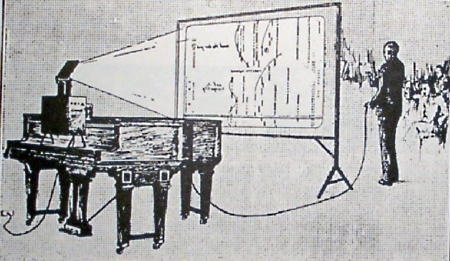

The artist's drawing, shown above, illustrates what might be a "fantasy" concerning the use of an opaque projector with the AudioGraphic rolls and/or the Visuola music instruction equipment. This 1928 picture was from an "institutional brochure", published by The Aeolian Co., but it lacks the finesse and artistic layout of their usual advertising efforts. That, along with the rather 'odd' appearance of the spoolbox projector, suggests that an "idea" was being sold, which had probably not even made it to the "prototype" stage. This projector+roll system was being promoted only a few months before the stock market crash ended the project, in the next year.
Shown in the drawing is a Steinway AR - the 7' player, an example being used in The ARTCRAFT Studio, today, and - as usual - the electrical cords and cables are draped all over the place, to imply that the Duo-Art 'reproducing' player had something to do with electronics — radio and talking pictures being among the current developments. (Of course, this was a standard pneumatic-mechanical instrument, so beyond the projector bulb - and fan? - plus the rotary pump for the Pianola action, and some kind of start|stop switch on the instructor's cable control, the product was still the old player instrument featuring the same perforated roll arrangements, but "gussied-up" for educative purposes. The rear projection screen concept borrows from the Trans-Lux ones, for movie projection and/or screen tints, in use at the Roxy and other deluxe cinéma houses, of that day.)
How the teacher would control the roll speed is left to the imagination. A good instructor would have to compensate for the tempo acceleration, after a few minutes of playing time. The basic start|stop lines on the American rolls - or "(S)" stamps on the British editions - would not be enough for a detailed presentation. It's not known, either, whether there was a play|rewind control, but it's likely ... on that external cable ... since these were in use for the modified grand pianos featured on Aeolian Hall concert demonstrations. Start|stop and play|rewind functions would be a simple proposition, at that time, but graduated roll speed control would have presented a few hurdles in player action modification.

We have attempted to "enlarge" the drawing of this mysterious spoolbox projector, and here are some observations, based on the fuzzy illustration — It appears to sit on the keyboard cover, directly, without any clamps or alignment features. Removing this unit, in order to change an AudioGraphic roll, would present a few problems, due to the heat that opaque projectors are known to generate ... and ... where does one place this tungesten-bulb accessory, on the floor? (Perhaps the system had to be set up for 1 roll only, but that wouldn't make sense for a music class!) Notoriously dim, even with a cooling fan, an opaque projector looks odd, in this setting. Perhaps the device was something drawn with artistic license, rather than portraying the REAL model, created for Duo-Art spoolbox purposes.
"Touring" an AudioGraphic Roll of Grieg's LITTLE BIRD
Note that the Composer in these educational rolls gets the larger picture and that the 'pianist' has a reduced billing. By 1926, when AudioGraphic releases began, it was obvious to any music teacher that the Duo-Art rolls did not "reproduce" an artist's performance. However, they could be used for music appreciation classes, so the Composer - not the keyboard 'artist' - was stressed. AudioGraphic box labels featured the Composer and Title in Bold Print, always in English on the American releases. Many times the 'recording pianist' would be left off the box label, entirely, or included with small type, since his or her "performance" was not the focus of this late Aeolian project. Clearly, Aeolian scrambled to get schools and colleges signed-up for the recycling of their existing library, based on musical composition and the history of composers.
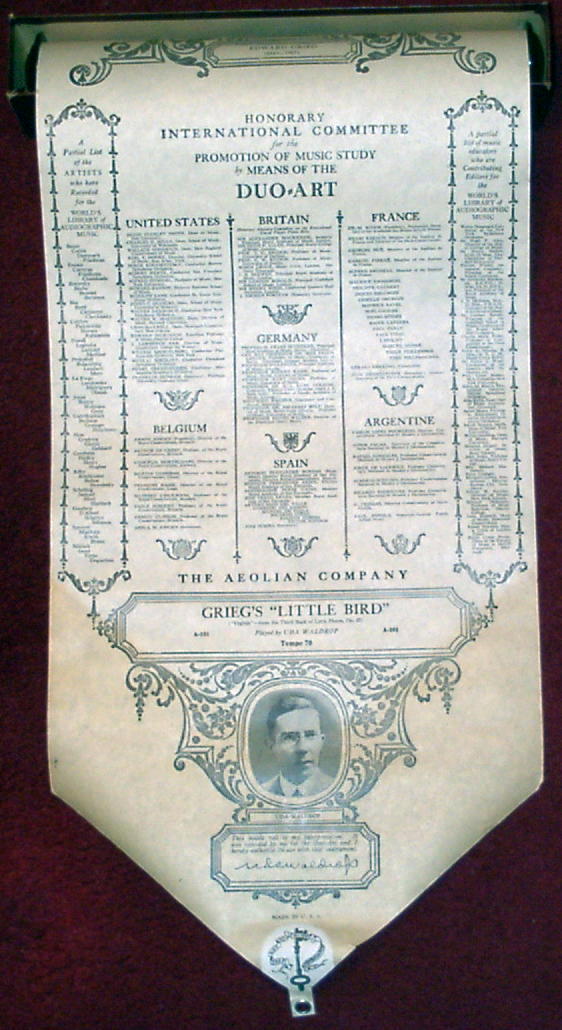
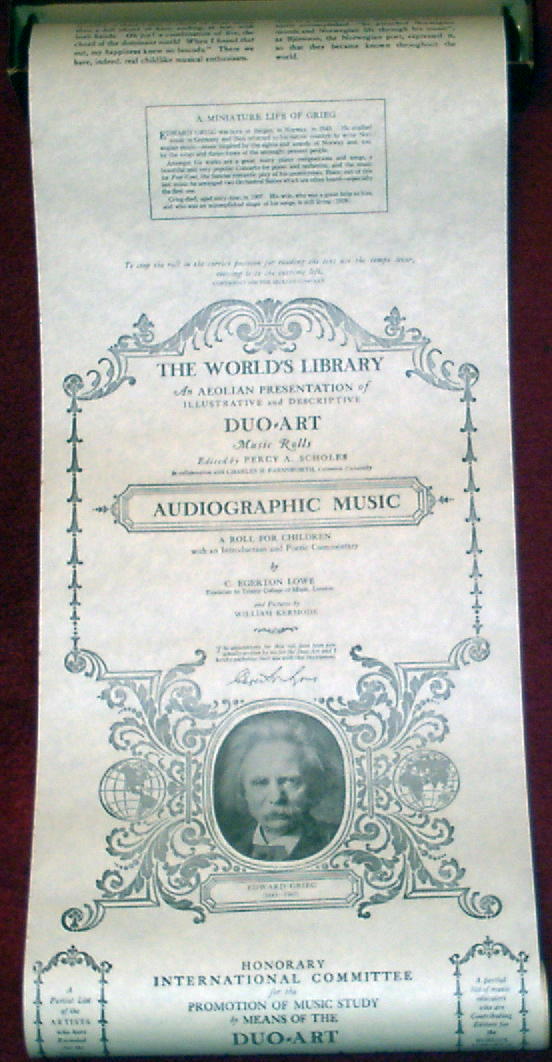
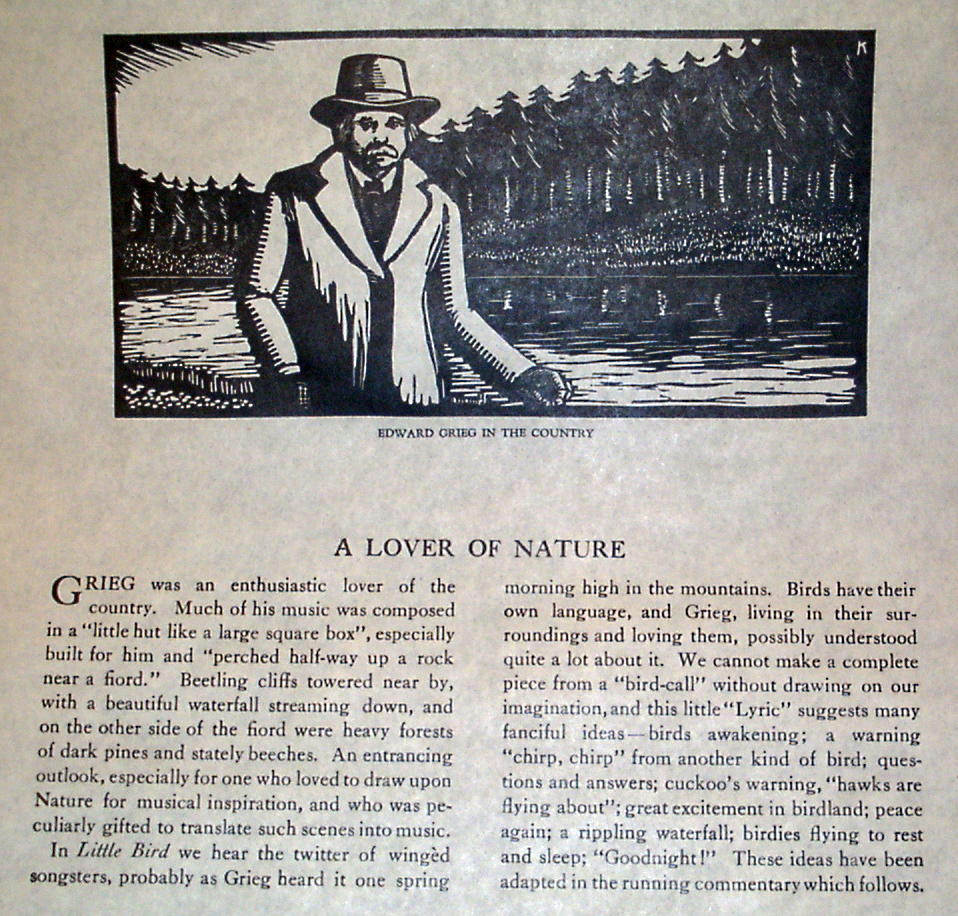
Two views of the leader for LITTLE BIRD, "played by Uda Waldrop" ... an arrangement probably 'recorded' between '22-'23, when the pianist would have been at Aeolian Hall, To the right is a typical disseration about the Composer. The instructor (or Pianolist, at a standard instrument, without using a projector) would STOP the roll, at various marked places — not shown, in these illustrations — so that the lengthy texts could be read ... before the music began.
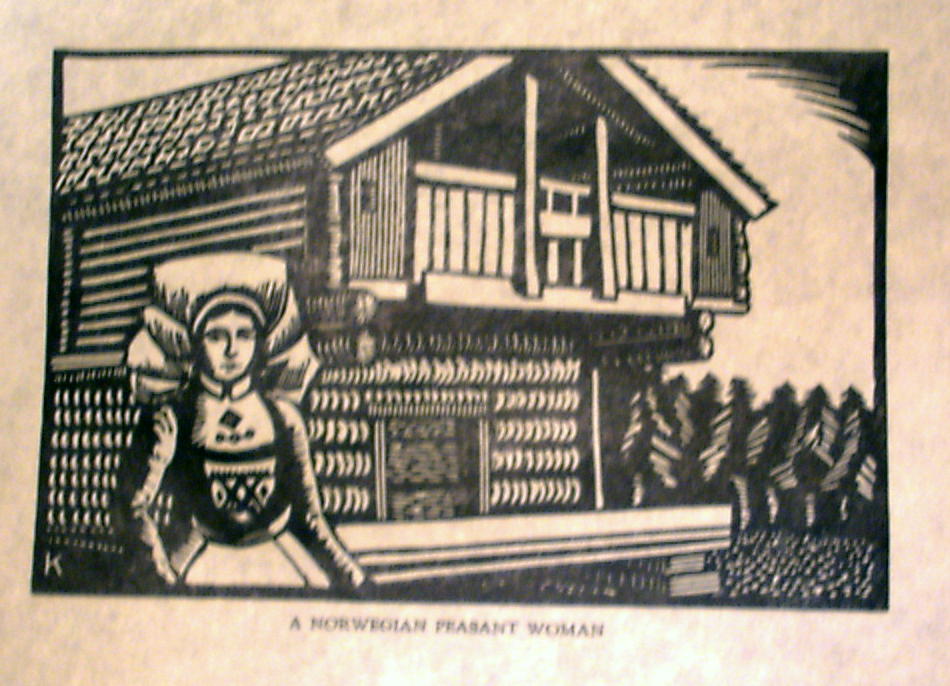
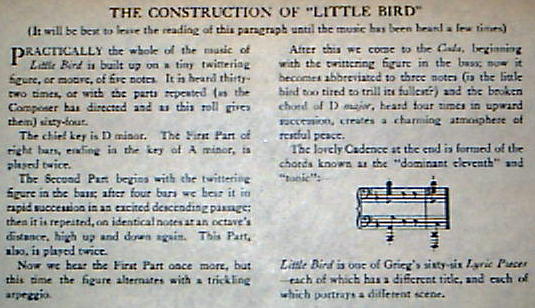
Two snippets, more, from LITTLE BIRD on AudioGraphic Rolls. More commissioned artwork, plus a short treatise on musical form for this composition.
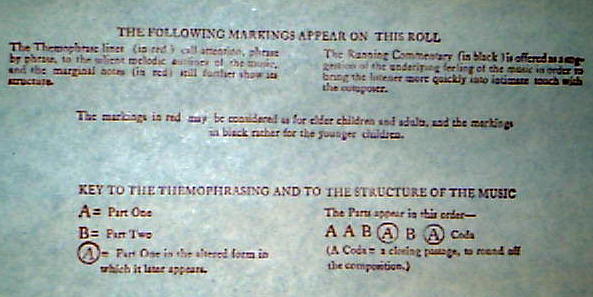
Called "THEMOPHRASING" (!), there were usually short sections, printed in red ink ... just seconds before the music roll began its performance. These contained the musical structure, which is A, A, B, A modified, B, A modified, Coda. The A-series usually had a "story" created for the rolls, so the preface suggested that adults and old children could concentrate on the red printing, while youngsters could read the remarks that appeared in black rubber type.

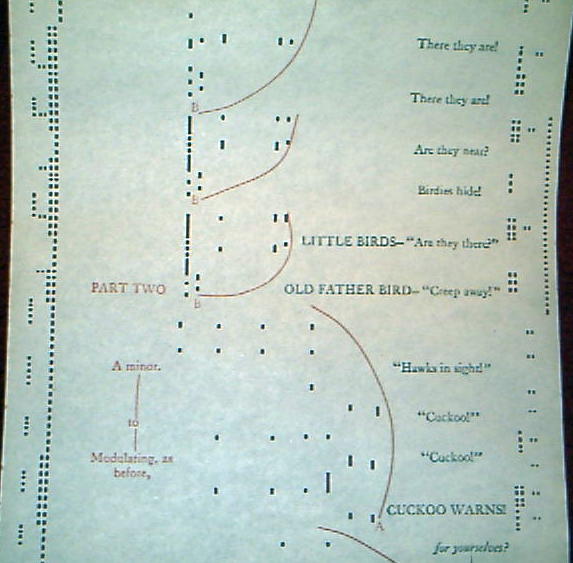
These 2 views of LITTLE BIRD show Aeolian's AudioGraphicTEMPOPHRASE LINES at their best. The groups of each theme (A and B) are exactly what a Pianolist "sees in his/her mind", while interpreting standard rolls without such markings. The kiddie story, on the right, was concocted by the player roll industry, and is typical of the time: "Birdies, awake!" ... "Look out!" ... "Cuckoo!" ... "Hawks in sight" ... and plenty of "tweet, tweet, tweet" splashed throughout the perforated arrangement.

The viewer gets a Quiz, just before rewinding the roll. While a beneficial part of AudioGraphic Music, these question-and-answer "finale" stampings were not on most of the Duo-Art releases. Typically, they appear on shorter rolls, especially those which could be demonstrated in a retail store situation. Most of the university or institutional rolls did not feature the Q&A sessions, nor did they have the "entertain the kiddies" material, running along the right side of the music sheet.
Debussy's MOONLIGHT, on an AudioGraphic Roll

This "played by George Copeland" (W. C. Woods) roll shows the extended lines for Aeolian's TEMPOPHRASING. Since there's not much of a story to this gem of French Impressionist music, the annotations for children just feature widely-spaced adjectives, beginning with a description of the melodic texture. Note how primitive the Aeolian Duo-Art expression is, here: FROZEN accompaniment set against a lackluster theme, with nonstop Soft Pedal carrying the dynamic load! If this were a modern Interpretive Arrangement by ARTCRAFT, both the accompaniment and 'solo' would be "floating", all the time. There are many musical opportunities inherent in the expression of this roll, and LITTLE BIRD, above, where just 2 combinations of the 'solo' holes (on the right) are being used.
Owners of a Duo-Art Pianola have the luxury of overriding anemic expression, of this kind, with the levers for graduating the Theme and Accompaniment. If the pneumatic controls, which "tug" on the same levers are not doing much, the Pianolist can get involved with the musical presentation.
A British 88-Note AudioGraphic Roll
POLONAISE in A-Flat by Chopin, "played by Hofmann" (Woods)
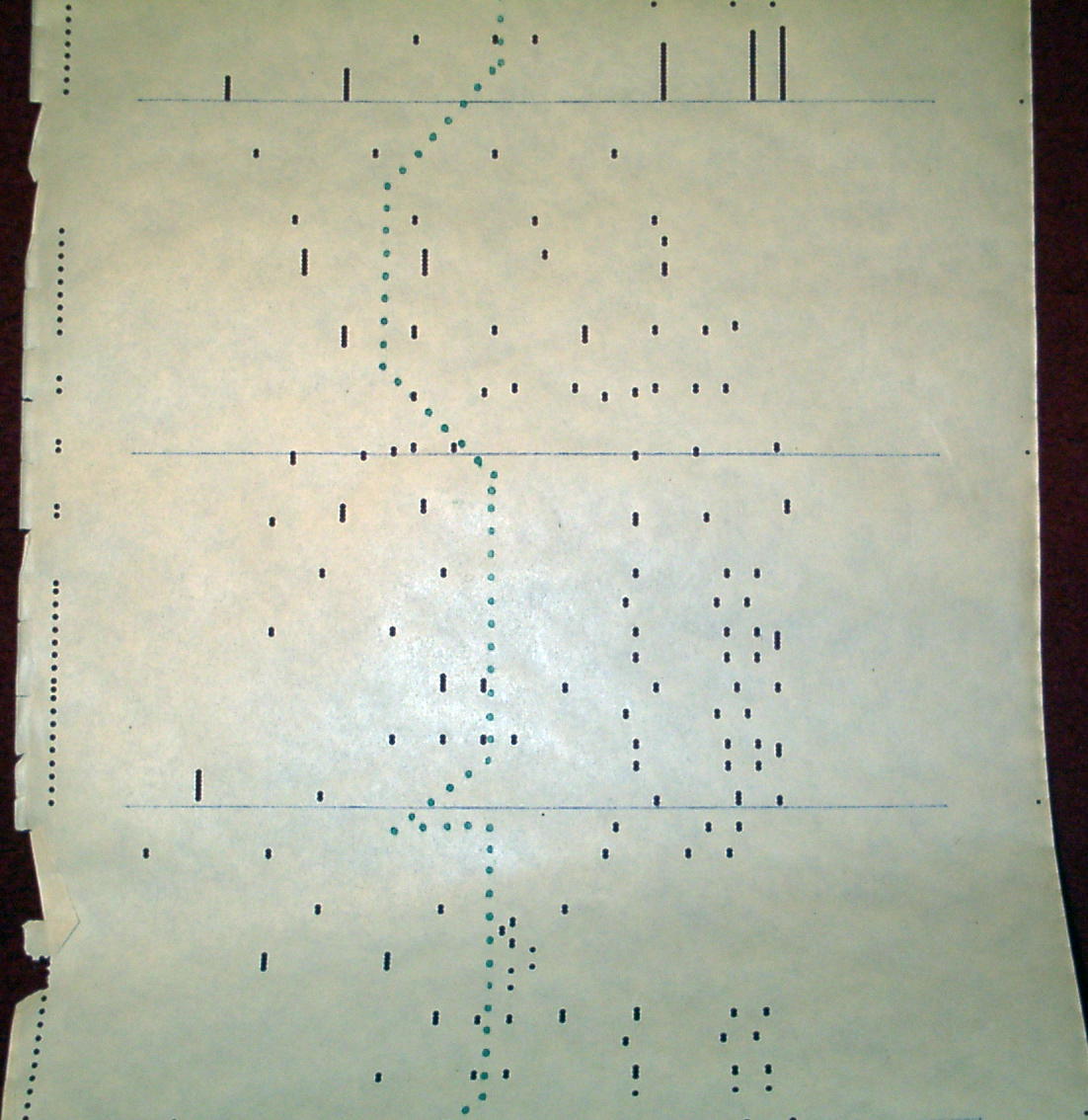
Unlike the Aeolian Co. in the United States, the British subsidiary published rolls in both the Duo-Art 'reproducing' (expression player) format and the standard 88-Note edition, shown above. Not shown is the equally-elaborate leader, of British design ... which advertises the "'Hofmann' performance" in small print; the box label doesn't even mention the alleged 'pianist'! What's amazing is that Aeolian Ltd. left off the Themodist accent perforations (those double holes, shown on the bass and treble margins — in the Grieg and Debussy rolls, above). These 'solo' perforations would have been featured on most of their standard music roll releases. (Why?)
Seen here are the idiotic "measure lines" which were patented and promoted by Reginald Reynolds, the English equivalent to W. Creary Woods, in the States. Most of Reynolds' rolls were nothing more than sheet music transfers, so by imposing 'bar lines' across the roll, that divorced the interpreter even MORE from the "performance aspect". The whole idea of the player is to present a vibrant performance, not just "'play back' sheet music"!
Typically, British Aeolian rolls are torn on the left margin. This was a combination of a 'rough' single finger tracking system, wooden spools without flange adjustments and thinner, cheaper quality paper. This roll was purchased on eBay for "show-and-tell" purposes, not musical performance. Actually, the Duo-Art edition of POLONAISE in A-Flat, "performed by 'Hofmann'" (Woods) is one of the best in the entire Aeolian library. We have it on a domestic AudioGraphic Roll for schools, so it features many of the red annotations, shown above, and none of the "kindergarten" monologue — printed in black type.
The British "PIANOLA Practice Roll" #3 — a rotten example of foreign AudioGraphic releases!
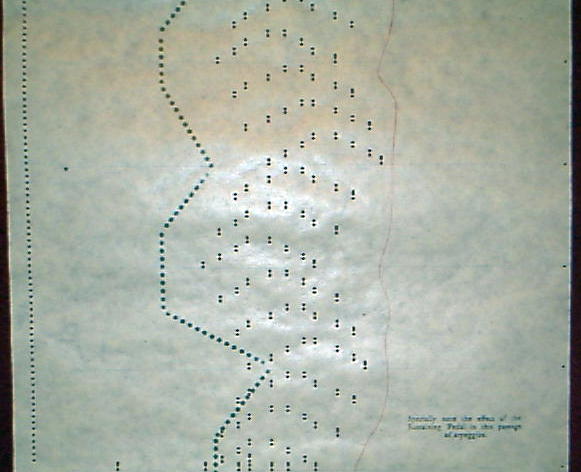
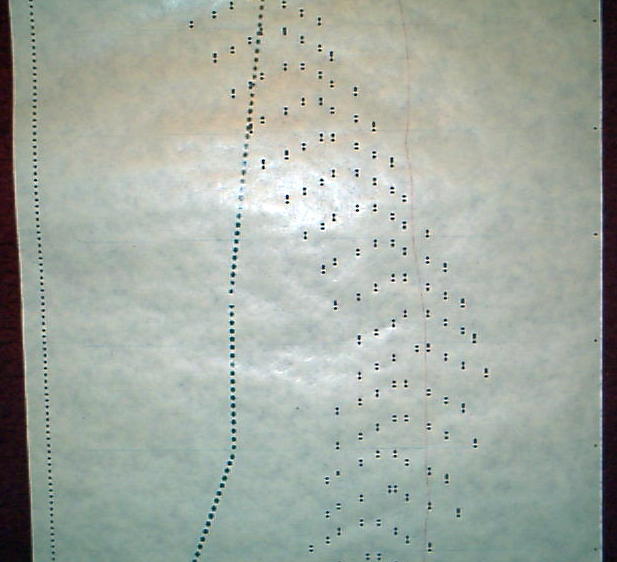
Reginald Reynold strikes again, with this 88-Note AudioGraphic roll, given with the purchase of any Pianola in the British Empire. We are skipping the music arranged for Tempo 30 and Tempo 40. (Do you have such rolls in your collection? I doubt it!) This is the cadenza from Percy Grainger's WALTZ OF THE FLOWERS by Tchaikowsky, again, one of the better arrangements in the original Duo-Art library, albeit with clumpy staccato cuttings.
Here, we are given "connected notes" — as in organ playing! — direct from the sheet music notation score. Then, a small section of AudioGraphic type, on the left picture, tells the listener to "note the effect of the sustaining pedal on this music". Effect? It's disgusting!! That long perforation, running on the left of both images, is a nonstop "stuck on" automatic sustaining pedal. What should be virtuoso, effervescent staccato playing (somewhat achieved on the "Grainger" Duo-Art roll) is a cacophonous muddle, and "instructions?" of this kind no doubt accelerated the demise of British Aeolian, a number of years before the American company experienced any financial difficulties.
When the industry ended, W. Creary Woods went on to teach at the Curtis Institute of Music in Phildelphia, being an arranger-musician of the highest order (given the working conditions and resources of that time). Reginald Reynolds floated from Aeolian Ltd. to Marshall & Rose (the English maker of "Angelus" players) and finally on to Harrod's department store, in London, where he became a salesman-demonstrator, until his retirement in the late 'Thirties. (Harrod's took over the English Aeolian business, and continued with players, well into that final decade.)
Return to ARTCRAFT Newsletter #11